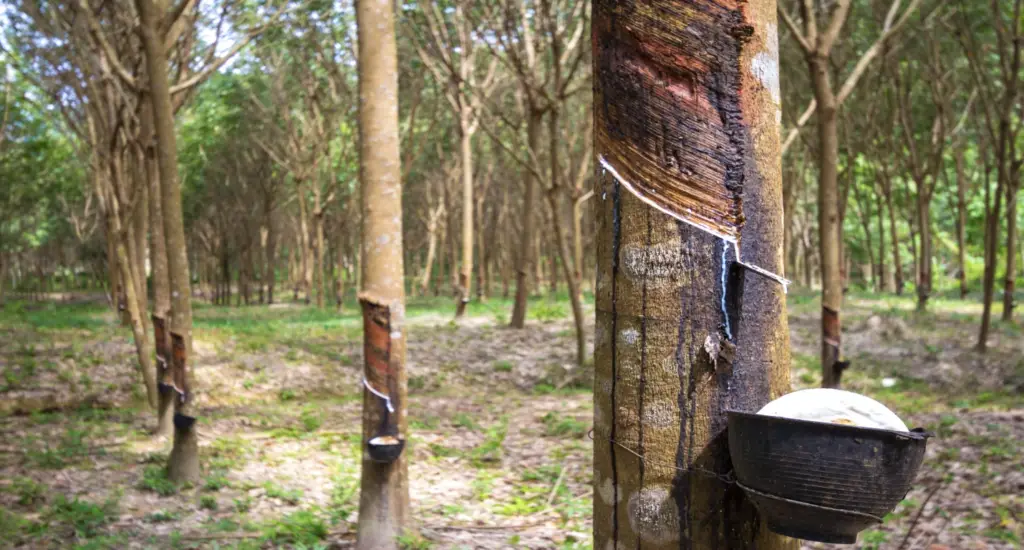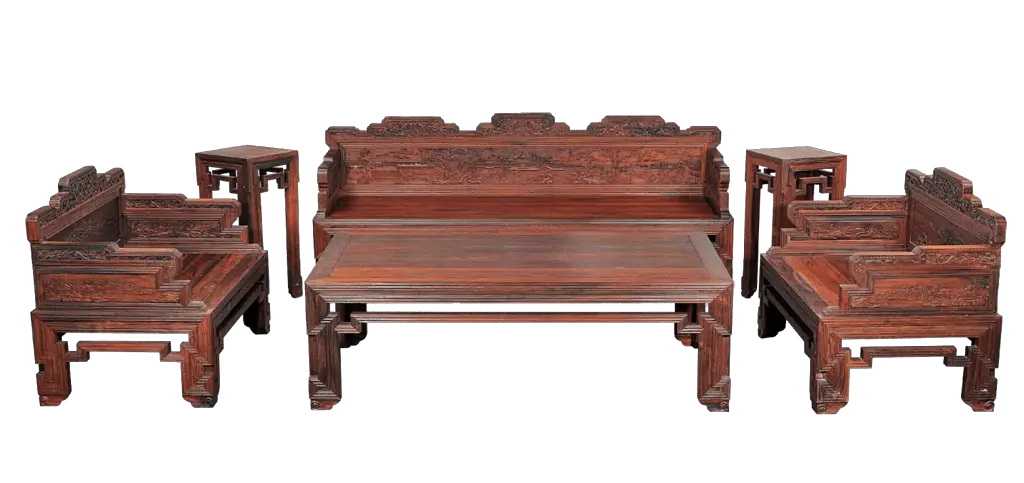When I heard rubberwood, I immediately thought it must be synthetic wood like plywood. Upon learning more about rubberwood, I realized it is a sustainable resource.
I am writing this post in case you are in a similar situation & want to know more about rubber wood.
In this post, I am going to cover:
- What is rubberwood & its properties?
- Advantages & disadvantages of rubber wood
- Use cases for rubberwood
- Maintenance tips
So let’s get started.
What is Rubberwood?
Rubberwood is a hardwood obtained from a rubber tree. Its scientific name is scientific name Hevea Brasiliensis & it is also known as the Para Rubber tree.

A rubber tree can grow up to 100-130 feet tall and live for up to 100 years.
Rubber trees can be found in Asia, Africa, and America. In general, rubber trees are harvested for their latex, and they yield latex until the age of 30 years. Thereafter, these trees are used for woodworking and construction projects.

Rubberwood has a light blonde to medium tan color and a medium density.
Properties of Rubberwood:
Below are a few important properties of rubberwood:
| Colour Appearance | Rubberwood usually has a light color. Rubberwood typically has a pale cream to yellowish brown shade. |
| Density (Green Wood) | 800 Kg/m3 |
| Density (12% of Moisture Content) | 600 to 620 Kg/m3 |
| Relative Density | 0.63 to 0.66 (i.e. quite heavy timber) |
| Bending Strength: 1. Modulus of Elasticity 2. Modulus of Rupture 3. Sheer Parallel to Grain | 9240 N/mm2 66 N/mm2 11 N/mm2 |
| Compression Strength: 1. Perpendicular to Grain 2. Parallel to Grain | 4.69 N/mm2 32 N/mm2 |
| Gluing Properties | The gluing strength of Rubberwood is quite high due to which it can easily stick to most adhesives. |
| Durability | Rubberwood is durable enough to withstand bacterial and fungal attacks. It also resists mold growth. |
| Machining Property | On rubberwood, various machines and tools like saws, machines, bores, etc are easy to use. The surface remains smooth even after using various machines or tools on it. |
Uses of Rubberwood:
As time passes, Rubberwood is being utilized more and more.
One of the common uses of rubberwood is furniture. Tables, chairs, beds, and other pieces of furniture are made of rubberwood.
Rubberwood is even used as fiberboard and chipboard.
It is also used for cabinetry, kitchen accessories, interior millwork, paneling, handicraft products, wooden floors, shelf construction, etc.
What are the advantages of Rubberwood?
So some of the most talked about advantages of Rubberwood are listed below:
1. Scratch Resistant: Rubberwood is a hardwood with a Janka Hardness rating of 995 lbs which makes it strong enough to resist scratches & dents.
2. Highly Durability: It is highly durable because of its high strength & density. Rubberwood furniture lasts for 10-15 years and requires very little maintenance.
3. Low Maintenance: Rubberwood doesn’t require any sort of special care. In order to maintain it, you only need to wash it with soap and water & dry it with a clean cloth. It does not require any sort of special care.
4. Eco-Friendly: Rubberwood grows rapidly, and it is easy & fast to harvest. As such, rubberwood can be considered an eco-friendly wood since it has no negative impact on the environment.
5. Affordable Price: Since it is quite easy to plant rubberwood trees, there is not much problem with the supply of rubberwood. Due to its high supply, its price remains low in comparison to other woods that possess the same properties. This is the reason why rubberwood is considered a cost-effective material.
What are the disadvantages of Rubberwood?
In addition to rubberwood’s many benefits, it also has some disadvantages. Some of the major disadvantages of rubberwood are given below:
1. Not Meant For Outdoor Usage: Rubberwood is not a suitable choice when it comes to outdoor usage, because of its moisture absorption property. When rubberwood is kept outside, it will start to decay & destroy very fast, so keeping it outside the house is not at all a wise idea.
2. Warping & Twisting Defects: When rubberwood is kept for drying, there are high chances of twisting and warping defects occurring. Due to these defects, the rubberwood will start distorting and deteriorating with time. These are common defects in rubberwood.
3. Latex Allergies: Rubberwood produces latex for up to 30 years. After that, they are used to produce timber. Chances are low but still, it can cause latex allergies. Many people are allergic to latex & if you are one of them, rubberwood is not for you.
4. Require Heavy Treatments: Rubberwood is susceptible to attack by fungi and insects. Consequently, it needs proper seasoning and heavy chemical treatments to resist them.
Is Rubberwood ideal for making furniture?
Yes, rubberwood is suitable for making furniture because of its durability, easy-to-use nature & affordable pricing. Also, due to its easy-carving nature, you can carve different patterns and designs on it.

Rubberwood is a low-maintenance wood which again makes it great for furniture purposes.
When it comes to cleaning and maintaining furniture, people don’t have much time, so Rubberwood is an option if you’re looking for easy-to-clean furniture.
Furniture made from rubberwood is best suited for indoor use, such as tables, chairs, shelves, wardrobes, and beds.
When it comes to outdoor furniture, rubberwood is not a suitable choice. Because this material absorbs moisture well, is vulnerable to insect attacks, and is prone to twisting and warping.
How to maintain Rubberwood furniture?
Rubberwood is not so difficult to maintain. It just needs a little bit of cleansing.
In the few steps given below you can easily take care of the Rubberwood furniture:
- You just need to use a dry cloth to dust off the furniture and in this way you can clean the furniture. You can do this weekly.
- In order to clean rubberwood furniture that is too dirty, you can use mild soap and water and then dry it with a cloth.
- In order to clean any kind of spilled liquid you need to use a cloth that can easily absorb the liquid.
Why is Rubberwood cheap?
Rubberwood is cheaper than lots of other alternatives and to support this there are lots of reasons given below:
- Rubberwood is the byproduct of the rubber plant and for this reason, it is cheaper than lots of other woods.
- Rubberwood is also easily available on the market, making it a cost-effective wood.
- In terms of quality, rubberwood is not as good as other expensive woods. This explains why rubberwood is cheap.
- Rubberwood is easier to plant and harvest than many other types of wood, so it’s more affordable
Conclusion
In this article, I tried to cover everything that is of importance regarding rubberwood.
Rubberwood is affordable, durable, eco-friendly, sustainable & strong wood which makes it appropriate for any woodworking purposes.
Moreover, if you are considering rubberwood for your upcoming project, you can completely rely on it.
If you have questions about rubberwood, please leave a comment below.
